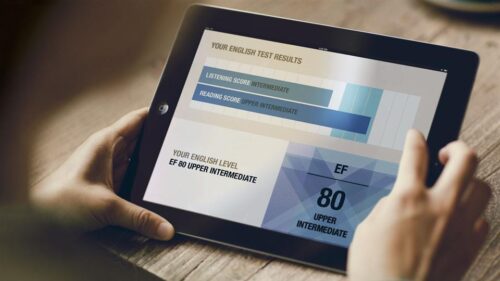When established, test-development leaders discuss their online English proficiency tests, similar themes emerge.
Online tests, most of which can be taken at home, have a wider reach than computer-based tests that are only available at designated testing sites, and are therefore more accessible for test-takers worldwide. People have more options for testing their English ability and can choose the method of delivery that’s right for them. In some cases, the online tests are also shorter in cost and duration.
“There was a need for a much more flexible option, which we had already considered, which was fast-tracked as a result of the pandemic.”
While the COVID-19 pandemic did accelerate the move toward home-based online testing, it did not create the need for these online tests. Some at-home tests were already in development prior to the global shutdown of testing centers in early 2020.
“This was not something we started only because of the pandemic,” said Fernando Fleurquin, director of marketing, communications, and stakeholder relations at Michigan Language Assessment (MLA).
He was discussing the introduction of MET (Michigan English Test) Digital, MLA’s online proficiency test that became available in October 2021.
“There was a need for a much more flexible option, which we had already considered, which was fast-tracked as a result of the pandemic,” he said.

Some other test companies were already offering online tests that could be taken at home. For example, Duolingo introduced a strictly online test in 2017 and has since risen as a leader in online testing.
In an effort to adapt to the changing landscape of English proficiency testing, nearly all leading companies now offer online tests that can be taken at home. This will mitigate the disruption of any future test-center shutdowns, but that’s not the only thing to consider with high-stakes tests.
Top-notch quality must be maintained, and test security is vital. Universities, businesses, and institutions that require these tests must feel confident in accepting the results. And of course, test-takers need tests that will best assess their abilities and help them achieve their academic or career goals.
By most accounts, the standards for English proficiency tests, whether taken at home or on-site, remain high.
What Tests Are on the Market Now?
Creators of high-stakes exams have been rolling out new offerings since the onset of the COVID-19 pandemic.
Within six weeks of the global shutdown of testing centers in 2020, ETS (Educational Testing Service) came out with TOEFL iBT Home Edition, which was modeled exactly after TOEFL iBT.
The online test was developed in direct response to the pandemic and, at the time, was considered a temporary measure until in-person testing safely resumed. However, the exam is now a permanent part of the TOEFL portfolio.
“The decision to keep this test format is consistent with trends of increasing online/remote testing and was driven by the success and popularity we’ve seen with TOEFL iBT Home Edition in the market to date,” said Srikant Gopal, executive director of TOEFL/ETS.

In August 2021, ETS launched another new product, TOEFL Essentials. The idea for this newest test was in place prior to the pandemic, however, and Gopal explained why it was successfully accelerated.
“With the groundwork laid through the development and deployment of TOEFL iBT Home Edition, and the success we’d witnessed in the test administrations, launching TOEFL Essentials test was a logical next step and a process we could speed up from its original timeline.”
One significant change to TOEFL Essentials is in the content, which is 50% academic and 50% general English. That’s compared to TOEFL iBT’s 100% academic content. The change does not impact the effectiveness of the test.
“The content in TOEFL Essentials is robust enough to measure somebody’s ability to do the work on campus or in other situations,” said Gopal.
When it comes to offering online English proficiency tests, other established companies have followed suit.
IELTS (International English Language Testing System) offered IELTS Indicator, a temporary option to take the test at home, when test centers shut down.
An April 2020 press release described IELTS Indictor as “a reliable interim measure” until the test could be safely resumed at test centers.
As it turns out, the online option will no longer be just a temporary solution. In early 2022, IELTS Online will become available, providing test-takers with a permanent, online solution. The new test will follow the same format as IELTS Academic.
All of this leads to greater test accessibility.

“By making the world’s leading test available online, we aim to empower even more people to take IELTS and follow their ambitions,” said Christine Nuttall, managing director of IELTS at Cambridge Assessment English in a press release.
Pearson, another leading test publisher, also has a new digital product. For many years, they’ve offered the widely accepted PTE Academic, which had always been taken in test centers by potential students and those fulfilling visa or immigration requirements.
Pearson recently made two major changes. In November 2021, the duration of PTE Academic was reduced from three hours to two hours. Then in January 2022, PTE Academic Online became available to take at home.
Pearson developed the online test when the pandemic shut down test centers and restricted travel. It is now a permanent part of their testing portfolio.
The new online version maintains the same format and scoring procedure as PTE Academic. One significant difference, however, is that PTE Academic Online is not accepted for visa or migration purposes.
According to Melanie Drake, global training and content manager at Pearson (London), whether the test is being taken at home or at a test center, the reduced timing provides a better testing experience overall.

“It really allows test-takers to focus and concentrate effectively on test day because a three-hour test, by the end of that session, it’s fair to say there might be a little dip in stamina.”
Another new test, the MET (Michigan English Test) Digital was created by Michigan Language Assessment. Both test and test company have undergone changes throughout the years.
In 1953, the English Language Institute at the University of Michigan developed their first English language test, followed by many more over the decades. In 2010, Cambridge Assessment English teamed up with the testing division of the ELI and formed the nonprofit Cambridge Michigan Language Assessments. The organization then rebranded in 2018 and became known as Michigan Language Assessment.
For many years, MLA’s high-stakes product was the Michigan English Language Assessment Battery. It was used for high-stakes decision-making such as university admissions and for proof of language efficiency in the healthcare field.
MELAB was discontinued in 2018 and replaced with MET, a four-skills paper-based test which was also used for high-stakes purposes. Then in October 2021, MLA rolled out MET Digital, which follows the same format as the paper-based MET.
Their MET products now include the digital 4-skill exam as well as a digital 2-skill exam. The latter is also still available in a paper-based format. Digital tests can be taken at home or at designated test centers. Prior to MET Digital, MET could only be taken at a test center.
The 4-skill exam is used for high-stakes decisions in universities in the U.S. and abroad, in both English and non-English speaking countries. Professionals who come to work in the U.S. may also be required to take it.
“There are many healthcare nursing boards in different states in the U.S. that accept it for foreign-trained professionals that want to work here,” added Fleurquin.
The 2-skill MET Digital assesses listening and reading and is used by institutions globally who may require only a partial picture of language performance.
“We had already started with initial planning of digital projects for our exams before the pandemic. In 2020, we fast-tracked our plans as a result of the lockdowns and global stakeholders’ needs for digital delivery of secure assessments and certification solutions.”
The MET Digital test also offers different pricing options. Cost varies by country, but the 2-skill test costs $80 on average, compared to $150 for the 4-skill test. Both can be taken at home or in authorized testing centers.
Fleurquin expanded on the pandemic’s influence on MET Digital.
“We had already started with initial planning of digital projects for our exams before the pandemic. In 2020, we fast-tracked our plans as a result of the lockdowns and global stakeholders’ needs for digital delivery of secure assessments and certification solutions.”
In addition to the high-stakes tests above, low-stakes tests are also an important part of the English testing landscape. They help place students into accurate class levels, they monitor progress, and teachers often use them to pinpoint student strengths and weaknesses.
Two prominent companies with online placement tests now on the market are National Geographic Learning and Kaplan.
National Geographic Learning introduced their new English placement test in August 2021. Though the company, which is part of Cengage Learning, has always offered placement tests tied to their own coursebooks, the new test is the first one in which they’ve teamed up with assessment experts, in this case a company called LT123.
The result, the National Geographic Learning Online Placement Test, is an adaptive test that assesses reading, listening and use of language. It’s accessible on both desktop and mobile and is intended for learners aged 15 and up. The test is used primarily at private language schools and universities, both in the U.S. and around the world.
“Anybody who needs to place a lot of students accurately, reliably and at scale, this is the program for them,” explained Caitlin Thomas, senior manager of product marketing at National Geographic Learning.

As for the timing of the test, the concept and development began prior to the onset of the pandemic, while development and user testing continued into the pandemic.
Another assessment with online availability, Kaplan International Tools for English, pre-dated the pandemic by several years. It was initially developed as an internal tool more than a decade ago, primarily to place students at Kaplan language schools.
Then in 2016, it was made available online to test-takers outside of Kaplan programs. Those test-takers typically include students at schools, colleges and universities around the world, where it’s mainly used as a diagnostic and progress-tracking tool.
When the test became more widely available in 2016, accessibility was key.
“It’s truly global,” said Kaplan International Tools for English product director Peter Coulam. “It’s accessible to everyone. It’s web-browser-based so no one needs to download any software to make it work.”

The online availability proved beneficial when test centers closed.
“When the pandemic hit last year, a lot of our clients were already using it. Schools, colleges and universities were all closed so they were happy they’d gone with our test,” said Coulam.
Test are Getting Shorter and Adding New Features in an Increasingly Competitive Market
“We added the option of retaking one section of the test to offer test-takers the possibility to really show their best performance.”
In the crowd of online English proficiency tests, each needs to rise above the others with unique features. This may show up in various ways.
One standout feature of MET Digital is that, once test-takers receive their results, they can choose one section of the test to retake. This must be done within a limited window of time and there is a small additional fee, but the higher of the two scores will be recorded as their final test results.
This detail was developed after consulting with educational institutions, professional organizations and test-takers, according to Fleurquin.
“We added the option of retaking one section of the test to offer test-takers the possibility to really show their best performance,” he said, adding that it may help relieve the pressure of trying to take a perfect test the first time.
“They have a second chance.”
In the case of Pearson’s PTE Academic Online, while it follows the same format and question types as their existing PTE Academic, a significant feature of the new test is the personalized feedback each test-taker receives along with their results.
“This has tailored recommendations, which are linked to our global scale of English based on their performance,” explained Drake.
“We’re giving them recommendations of things they can actually do in order to improve the skills they need to work on, possibly before they need to take the test again,” she said.
ETS has also implemented significant changes in TOEFL Essentials which, unlike TOEFL iBT Home Edition, is an adaptive, multi-stage exam. Gopal explained that during the test, an adaptive engine is at work, estimating a test-taker’s language ability based on the answer to each item. The proficiency level of the items that follow are calibrated to target each individual’s language ability.
He further explained why TOEFL Essentials will stand out among online tests.
“I think it’s the first and only test in the marketplace that combines the unique combination of top-notch quality that institutions want and trust, along with student-friendliness, affordability and accessibility that obviously students really desire. So, both those attributes together in one package is what TOEFL Essentials is all about. And no one offers that.”
Lower-stakes tests that are typically used for placement purposes are filling a gap with their products, too.
Thomas, from National Geographic Learning, said one of their greatest resources is content, and that’s what sets them apart. For instance, one speaking item prompts test-takers to describe a National Geographic photograph.
Another value National Geographic Learning strives for is providing real and relevant test content. In the listening section, students hear a variety of accents, including those from speakers whose first language is other than English.
“Students had a lot of fun doing that. They had fun describing the photograph and, of course, having rich photography is part of the process.”
She described how, with the right photograph, one student can describe an image simply while another can describe it in greater detail with more complex language, depending on language ability.
“There are a lot of different ways and layers you could go with a photograph. And that gets people talking,” said Thomas.
Another value National Geographic Learning strives for is providing real and relevant test content. In the listening section, students hear a variety of accents, including those from speakers whose first language is other than English.
Kaplan International Tools for English also offers unique attributes. Coulam described how it stands out for its functionality, ease of use and flexibility. The test can be taken on any internet-enabled device, and clients use it for multiple purposes, from placing students in the appropriate classes to assessing them at the conclusion of a course.
Educators can also use the platform as a tool to not only track student progress but to evaluate the effectiveness of their own courses. Teachers can sample different course materials, try a different methodology or implement a change they think will help their students.
“If there’s some change and they want to evaluate the effect of that change on the progress of the students and on the instruction, the platform is sensitive to those changes,” said Coulam. “It’s been used several times for that purpose.”
Advantages of Online English Proficiency Tests
The biggest advantages of at-home proficiency tests appear to be accessibility and convenience. Global pandemic aside, test-takers can’t always travel to a test center.
“It might be because they’re living in a rural geographic location, or maybe there’s some sort of medical reason. So, we really wanted to make this as accessible as we possibly could,” said Drake, about PTE Academic Online.
Fleurquin spoke about the eased pressure that online tests such as MET Digital offer.
“Test-takers can take it whenever they want, where they want, where they can. That saves a lot of money, time and stress. They can be much better prepared for the exam.”
The National Geographic Learning Online Placement Test was also developed with flexibility in mind, providing options for where the test can be taken.
“We provide guidelines for best practices for the test to be taken at home … but we also envision a time where institutions are going back to normal face-to-face environments. So, it can be both, ” said Thomas.
Other advantages offered by some online tests are reduction in time and cost.
Compared to the two-hour TOEFL iBT, TOEFL Essentials is only 90 minutes long. It has also come down in price, and it costs, according to Gopal, “less than half of other major established quality tests in the marketplace.”
As with most major high-stakes English tests, fees vary depending on the test-taker’s location. Comparing fees for U.S. locations, TOEFL Essentials, at $110 remains significantly cheaper than TOEFL iBT Home Edition, which costs $235, and PTE Academic Online, which comes with a $215 fee.
As of February 2022, IELTS Online has not yet launched, while the cost of IELTS Academic in the U.S. is $245-$255.
Regarding the TOEFL portfolio, a great advantage lies in the options that test-takers are offered. With the rollout first of TOEFL iBT Home Edition and then TOEFL Essentials, ETS now offers two home tests, each of which appeals to different preferences.
“Some people will absolutely love the TOEFL Essentials experience,” said Gopal, “because it moves quickly, and it’s a shorter test.”
Others may prefer the longer test so they can take the time to study the tasks more thoroughly.
“So, it’s not that TOEFL Essentials is cheaper and shorter, and everyone’s going to go for TOEFL Essentials, not at all. Some people will feel more comfortable with TOEFL iBT format.”
Pearson has also reduced the time of PTE Academic from three hours to two hours, regardless of whether it is taken online or in a test center. This change occurred after research found an increase in the efficiency of the exam when the number of questions was reduced.
Is it Possible to Have Too Many Choices?
Dan Lesho is president of the ELT (English Language Testing) Society, an organization that strives to promote high standards in the global industry of English proficiency testing. He is also an admissions recruitment specialist at Notre Dame de Namur University in Belmont, CA.

He agrees that the increase in the number of tests is good for students.
“When you can give students a lot of options, that results in student mobility. That certainly is an advantage,” he said.
Lesho also described concerns on the side of university representatives about the sheer number of new English proficiency tests on the market.
“It really comes down to the ability to vet these new tests.”
He agrees that the increase in the number of tests is good for students.
“When you can give students a lot of options, that results in student mobility. That certainly is an advantage,” he said.
Lesho also described concerns on the side of university representatives about the sheer number of new English proficiency tests on the market.
“It really comes down to the ability to vet these new tests.”
After many years of relying primarily on tests like TOEFL iBT and IELTS, decision-makers gained “an institutional understanding of what the scores meant,” he explained.
Now, on top of creating and running language programs and the many tasks that come with that, admissions staff must interpret the results of any number of tests that are less familiar to them.
Familiarity with test scoring was a concern echoed by Kathleen Gutheil, director of international and transfer admission at Miami University in Oxford, OH.
Specifically, teachers may end up teaching to the test rather than focusing on developing language skills needed for success in the long run.
“We are still learning the nuances of different subject test scores and how they reflect a student’s real-world English preparation,” she said.
Lesho also brought up the number of new tests in regard to the washback in language testing, something that often occurs when impending high-stakes proficiency tests affect the design of class materials. Specifically, teachers may end up teaching to the test rather than focusing on developing language skills needed for success in the long run.
Lesho said that the items on established tests such as the TOEFL iBT are typically complex enough that successful language learning leads to exam success, so even when teaching to the test, negative washback is minimized. In other words, teaching language skills that will lead to success on the TOEFL iBT will also lead to increased success in language proficiency. Without mentioning any specific test, Lesho expressed concern that some newer tests may not live up to these same standards.
Test Centers Are Here to Stay
It’s coming up on two years now since the rollout of the TOEFL iBT Home Edition. Enough time has passed to understand that home tests are popular.
ETS surveys test-takers to gain insight into their preferences, and what they’ve found is that more than half of the students prefer taking tests at home.
“And remember these are people that have taken both formats,” said Gopal, “so they can make an accurate comparison.”
Despite the proliferation and popularity of online home tests, there are no plans from major companies to reduce the number of test centers.
Gopal said that the number of TOEFL test centers won’t be diminished, either now or in the future. For one thing, people are simply more familiar and comfortable with in-person tests because they more closely reflect the educational experiences they are used to.
Pearson won’t be reducing their number of test centers either.
“We’re always going to see that segment of learners who have real confidence in the stability of a test center experience. We’re never going to be taking that option away,” said Drake.
Furthermore, while PTE Academic scores may be used to fulfill immigration and visa requirements, the online version of the test does not. Those taking PTE Academic for that purpose must go to a test center.
And as we learned all too well from the pandemic when schools and businesses emptied out worldwide, not everyone has an adequate setup at home, something that MLA’s Fleurquin pointed out.
“Something that is inherent to the digital transformation of the entire world … is the gap that exists in terms of technology or internet access in some regions,” he said.
“So, it’s making sure that everybody has access to the technology that they need, the connection that they need to complete the test and to enjoy all the other benefits. That’s why we still offer the possibility of going to a test center, where they don’t have to worry about anything else.”
Adaptive Assessments Lead to Shorter Tests
According to leaders in the market, such as Kaplan, ETS and National Geographic, just because tests may be shorter in duration does not mean that quality is sacrificed.
Kaplan International Tools for English can be completed, on average, in about an hour. This relatively short testing time is thanks to the adaptive engine the test utilizes.
Coulam explained that the test begins with multi-level reading, listening and grammar questions. This is the starting point from which the system begins to estimate a test-taker’s level.
Then, using the test’s adaptive engine, “it will generate items which are at that level, and if they get the answer right, then it’ll ask a more difficult one to see if they get that right. If they get it wrong, they’ll get an easier question,” said Coulam.
The system begins with a wide estimation of proficiency and is then able to become more precise with each item until it pinpoints the accurate proficiency level.
“If you had a multi-level test from pre-beginner to advanced, and you wanted to test all those levels and all the skills in one test, that test would be huge unless it was adaptive. It would be 3-4 hours of testing rather than around one hour for Kaplan International Tools for English,” said Coulam, adding that the adaptive engine means students don’t have to answer questions that are either too difficult or too easy for them.
The number of items on an adaptive test is no fewer than for any other test; they are simply more efficient.
In describing the multi-stage adaptive format of TOEFL Essentials, Gopal also addressed the issue of how to assure a high-quality, highly reliable test that’s only 90 minutes long.
He explained that the test quickly ascertains a test-taker’s proficiency level and, after the first few questions, every question will be at the appropriate level.
“So, you need fewer questions. That’s what TOEFL Essentials does,” he said. “That’s the beauty of an adaptive test. That’s why we can get exactly the same reliability in a shorter time.”
Comparing TOEFL iBT and TOEFL Essentials, Gopal pointed out that while the latter takes less time, it contains more questions; the tasks are simply faster-paced.
“They’re more dynamic. It’s a more energetic experience whereas TOEFL iBT is a more immersive experience.”
Thomas from National Geographic described how adaptive testing brings out the best in test-takers.
“It continues to adapt throughout the stages of the test so that we are able to get those sublevel scores, and students are continuously given the opportunity to really show what they can do.”
Computer adaptive tests are not new to the world of assessment. Research on them began in the 1970s, and the first adaptive assessment was created in 1985. Their use became more widespread throughout the 1990s.
Adaptive assessments typically utilize Item Response Theory (IRT), a mathematical model that allows tests to adapt to the abilities of each individual test-taker. Like adaptive assessments, IRT was developed decades ago.
In many modern-day adaptive assessments, Artificial Intelligence (AI) uses algorithms based on IRT. As the advancements in AI become more powerful, so do adaptive engines.
Security in Online Tests Is Not Sacrificed
With regards to test security, stringent measures that require both human and Artificial Intelligence proctoring are now the norm.
“Before you start your session, you need to provide pictures of your testing area. Any papers need to be removed, as does your mobile phone,” explained Drake, in a discussion of taking PTE Academic Online.
This requirement is reflected in the protocols of other high-stakes tests as well. Rules may vary but, for the most part, at-home test-takers should plan to be alone in the room where they are taking the test. They may not leave the test area unless it’s during a designated break. In addition, all unrelated computer applications must be closed. AI technology may also use “gaze tracking” to make sure the user’s eyes stay on the test.
Response From Students and Institutions
Pearson is optimistic about the response they’ve had to PTE Academic Online.
“We’re seeing a real increase in demand because young people want to move forward in their lives. And so far, what I can definitely say is we’ve had a really strong response as well from recognizing universities, which is very important,” said Drake.
About TOEFL Essentials, Gopal explained why feedback from institutions has been so positive.
“TOEFL Essentials has been developed with the same exacting quality standards as the TOEFL iBT tests have been. And that means the process that underlies design, development, delivery and scoring is exactly the same process as TOEFL iBT.”
Test-takers have also given positive feedback about Kaplan International Tools for English.
“One of the things they like specifically … is the personalized study recommendations, which are generated after each test,” said Coulam.
Another aspect that has been positively received is the progress tracking. Test-takers can log into their accounts and see their prior test grades along with a trajectory of progress. They can also analyze prior study recommendations and consider what tips have worked best to help them improve.
“Having really global and novel content … that is related but also new, and not biased toward any one person or group in the world, is important. And students responded to that.”
Test-takers are also responding positively to the National Geographic Learning Online Placement Test. One reason mentioned by Thomas is that the test content not only engages students but allows them to see themselves in it.
“Having really global and novel content … that is related but also new, and not biased toward any one person or group in the world, is important. And students responded to that.”
She even shared one of her favorite quotes from a learner who took the test and later said, “It was a test I didn’t mind taking.”
Test-takers appear to agree that there are positive aspects to taking an English proficiency test at home.
Mohammed Khaled Ishtiaque is originally from Bangladesh. He has been living in the U.S. for the past eight years, and when he took the TOEFL iBT Home Edition in December 2021, he appreciated not having to go to a test center during the pandemic. He also liked the privacy the home test offered as well as the convenience of using his own computer equipment.
Steven Zhang, who is from China and is currently enrolled at the University of Wisconsin at Madison, took the TOEFL iBT Home Edition in July 2020. By the time he attempted to book the exam, all testing centers near him were full. He liked having the backup option of taking it at home.

Both test-takers, however, experienced difficulties during the test. During the reading section, Ishtiaque found the contrast between the text and background color difficult to read. He also cited a noticeable variation in speaking volume during the listening tasks, which was distracting.
For Zhang, the test paused twice and wouldn’t let him continue until he contacted a live proctor for help. For a timed exam, he thought that was a big disadvantage because of the added stress it caused.
Both test-takers agreed that, if presented with the choice, they would opt to take their next English proficiency exam at a test center rather than at home.
On the other hand, Sherry Hirano, a student from Japan, would take another at-home proficiency test. Hirano is deciding on which U.S. graduate school to apply to and has taken TOEFL iBT Home Edition twice. While she thought the fee for the home test was somewhat expensive, she liked using her own computer equipment and taking the test in the quiet of her own home, which helped her concentrate better.
As with the feedback from test-takers, feedback from institutions uncover both positive and negative aspects of home tests.
International students applying for undergraduate admission to Miami University can submit test scores from a wide range of online tests, among them are TOEFL Essentials and PTE Academic Online.
Gutheil, the admissions representative at Miami University, explained the importance of accepting so many different tests.
“With the onset of the global pandemic, the testing landscape changed dramatically. Access and testing methods for traditional tests were limited, if accessible at all. In order to allow students multiple ways to meet our English proficiency requirement in unique times, we expanded the number and types of English tests we accepted.”
She also pointed out that new tests must meet university standards.
“Newly approved tests are thoroughly vetted by our English as a Second Language instruction staff to make sure they meet Miami’s standards.”
Without singling out a particular test, Gutheil said that with the number of tests, there are concerns about test security. However, once students begin taking classes, they are monitored to make sure their academic performance correlates with whichever English proficiency test score they submitted.
Jason Chambers is the associate director of international admissions at the University of Cincinnati. The university, located in Cincinnati, OH, accepts results from several home proficiency tests including TOEFL iBT Home Edition, IELTS Indicator and Duolingo English Test.
Chambers said a major advantage is that remote tests “remove the huge barrier to students for scheduling tests often in other cities or far away from their location.”
Chambers said a major advantage is that remote tests “remove the huge barrier to students for scheduling tests often in other cities or far away from their location.” He also cited faster turnaround time in receiving scores on the admissions side.
And though he hasn’t noticed specific problems with any one test, he said that the chance of disqualified test scores is greater. Actions that may lead to warnings or disqualification include looking away from the monitor for too long or taking the test with others in the room.
He gave an example of students who go to internet cafes because they lack adequate internet connection at home. “This becomes a problem that we try to warn students about.”
Increasing Competition Improving Opportunities for Everyone
“I think what the availability of tests like TOEFL iBT Essentials, the broader iBT portfolio and indeed what other companies have also been launching—I think it broadens the options for universities to attract more diverse applicants from diverse geographies around the world.”
One outcome of the pandemic, at least in the world of English proficiency tests, is that test leaders are expanding their options and striving to create the best testing experience they can.
They have the advantage of looking at their competitors and analyzing what has gone right or wrong and making improvements that will likely benefit test-takers.
Drake discussed PTE Academic Online in relation to the various online offerings.
“Having a look at the individual components of these other tests, we do feel really confident we have one of the best out there, if not the best test out there right now. It’s shorter — we’ve got the shortest score turnaround in 1-2 days, in most cases just one day. And it’s seamless … it’s done all in one sitting,” she said.
As a final advantage, it’s likely that expanded test offerings will provide a wider pool of assessment options that universities can choose from, which Gopal explained.
“I think what the availability of tests like TOEFL iBT Essentials, the broader iBT portfolio and indeed what other companies have also been launching—I think it broadens the options for universities to attract more diverse applicants from diverse geographies around the world.”










